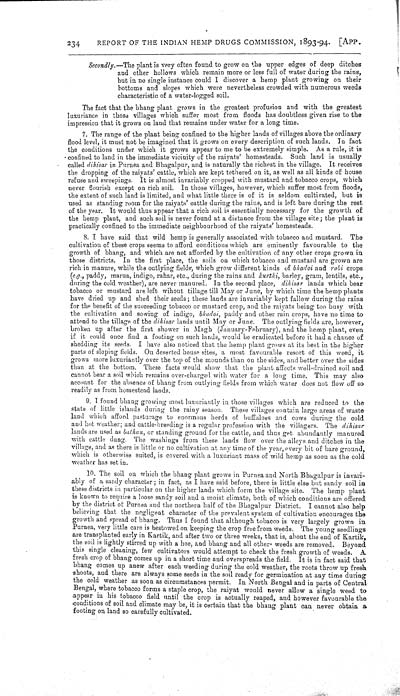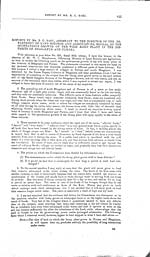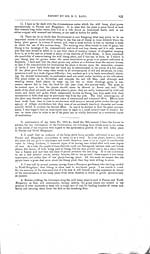Medicine - Drugs > Report of the Indian Hemp Drugs Commission, 1894-1895 > Volume III
(238) Volume 3, Page 234
Thumbnail gallery: Grid view | List view

234 REPORT OF THE INDIAN HEMP DRUGS COMMISSION, 1893-94. [APP.
Secondly.—The
plant is very often found to grow on the upper edges of deep
ditches
and other hollows which remain more or less full of water during
the rains,
but in no single instance could I discover a hemp plant growing on
their
bottoms and slopes which were nevertheless crowded with numerous
weeds
characteristic of a water-logged soil.
The fact that the bhang
plant grows in the greatest profusion and with the greatest
luxuriance in those villages which suffer most from floods has
doubtless given rise to the
impression that it grows on land that remains under water for a
long time.
7. The range of the
plant being confined to the higher lands of villages above the
ordinary
flood level, it must not be imagined that it grows on every
description of such lands. In fact
the conditions under which it grows appear to me to be extremely
simple. As a rule, it is
confined to land in the immediate vicinity of the raiyats'
homesteads. Such land is usually
called dihisar in Purnea and Bhagalpur, and is naturally the
richest in the village. It receives
the dropping of the raiyats' cattle, which are kept tethered on it,
as well as all kinds of house
refuse and sweepings. It is almost invariably cropped with mustard
and tobacco crops, which
never flourish except on rich soil. In those villages, however,
which suffer most from floods,
the extent of such land is limited, and what little there is of it
is seldom cultivated, but is
used as standing room for the raiyats' cattle during the rains, and
is left bare during the rest
of the year. It would thus appear that a rich soil is essentially
necessary for the growth of
the hemp plant, and such soil is never found at a distance from the
village site; the plant is
practically confined to the immediate neighbourhood of the raiyats'
homesteads.
8. I have said that
wild hemp is generally associated with tobacco and mustard.
The
cultivation of these crops seems to afford conditions which are
eminently favourable to the
growth of bhang, and which are not afforded by the cultivation of
any other crops grown in
those districts. In the first place, the soils on which tobacco and
mustard are grown are
rich in manure, while the outlying fields, which grow different
kinds of bhadoi and rabi crops
(e.g., paddy, marua, indigo, rahar, etc., during the rains
and kurthi, barley, gram, lentils, etc.,
during the cold weather), are never manured. In the second place,
dihisar lands which bear
tobacco or mustard are left wihout tillage till May or June, by
which time the hemp plants
have dried up and shed their seeds; these lands are invariably kept
fallow during the rains
for the benefit of the succeeding tobacco or mustard crop, and the
raiyats being too busy with
the cultivation and sowing of indigo, bhadoi, paddy and
other rain crops, have no time to
attend to the tillage of the dihisar lands until May or
June. The outlying fields are, however,
broken up after the first shower in Magh (January-February), and
the hemp plant, even
if it could once find a footing on such lands, would be eradicated
before it had a chance of
shedding its seeds. I have also noticed that the hemp plant grows
at its best in the higher
parts of sloping fields. On deserted house sites, a most favourable
resort of this weed, it
grows more luxuriantly over the top of the mounds than on the
sides, and better over the sides
than at the bottom. These facts would show that the plant affects
well-drained soil and
cannot bear a soil which remains over-charged with water for a long
time. This may also
account for the absence of bhang from outlying fields from which
water does not flow off so
readily as from homestead lands.
9. I found bhang
growing most luxuriantly in those villages which are reduced to
the
state of little islands during the rainy season. These villages
contain large areas of waste
land which afford pasturage to enormous herds of buffaloes and cows
during the cold
and hot weather; and cattle-breeding is a regular profession with
the villagers. The dihisar
lands are used as
buthan, or standing ground for the cattle, and thus get
abundantly manured
with cattle dung. The washings from these lands flow over the
alleys and ditches in the
village, and as there is little or no cultivation at any time of
the year, every bit of bare ground,
which is otherwise suited, is covered with a luxuriant mass of wild
hemp as soon as the cold
weather has set in.
10. The soil on
which the bhang plant grows in Purnea and North Bhagalpur is
invari-
ably of a sandy character; in fact, as I have said before, there is
little else but sandy soil in
these districts in particular on the higher lands which form the
village site. The hemp plant
is known to require a loose sandy soil and a moist climate, both of
which conditions are offered
by the district of Purnea and the northern half of the Bhagalpur
District. I cannot also help
believing that the negligent character of the prevalent system of
cultivation encourages the
growth and spread of bhang. Thus I found that although tobacco is
very largely grown in
Purnea, very little care is bestowed on keeping the crop free from
weeds. The young seedlings
are transplanted early in Kartik, and after two or three weeks,
that is, about the end of Kartik,
the soil is lightly stirred up with a hoe, and bhang and all other.
weeds are removed. Beyond
this single cleaning, few cultivators would attempt to check the
fresh growth of weeds. A
fresh crop of bhang comes up in a short time and overspreads the
field. It is in fact said that
bhang comes up anew after each weeding during the cold weather, the
roots throw up fresh
shoots, and there are always some seeds in the soil ready for
germination at any time during
the cold weather as soon as circumstances permit. In North Bengal
and in parts of Central
Bengal, where tobacco forms a staple crop, the raiyat would never
allow a single weed to
appear in his tobacco field until the crop is actually reaped, and
however favourable the
conditions of soil and climate may be, it is certain that the bhang
plant can never obtain a
footing on land so carefully cultivated.
Set display mode to: Large image | Zoom image | Transcription
Images and transcriptions on this page, including medium image downloads, may be used under the Creative Commons Attribution 4.0 International Licence unless otherwise stated. ![]()
| India Papers > Medicine - Drugs > Report of the Indian Hemp Drugs Commission, 1894-1895 > Volume III > (238) Volume 3, Page 234 |
|---|
| Description | Volume 3: Appendices. Miscellaneous. |
|---|---|
| Attribution and copyright: |
|




